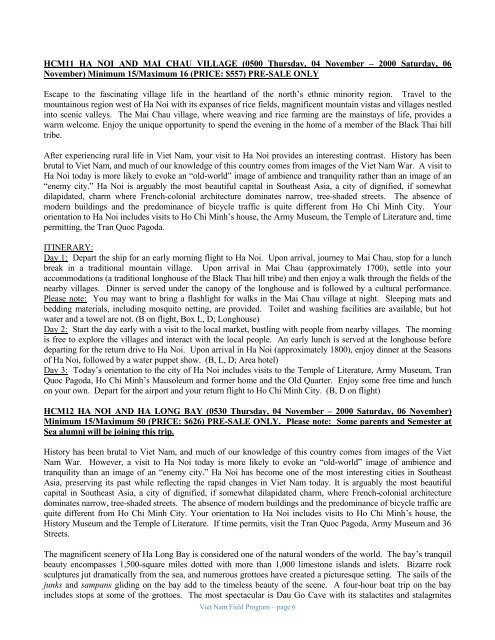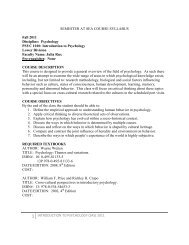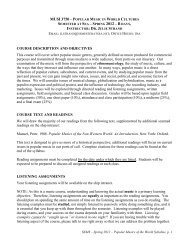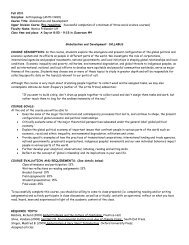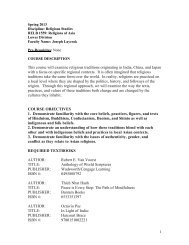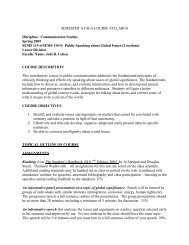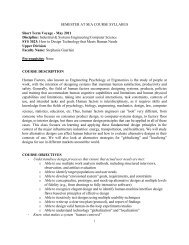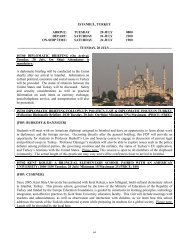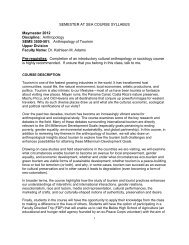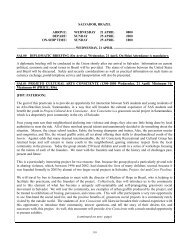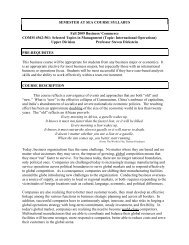Final Field Program - University of Virginia
Final Field Program - University of Virginia
Final Field Program - University of Virginia
You also want an ePaper? Increase the reach of your titles
YUMPU automatically turns print PDFs into web optimized ePapers that Google loves.
HCM11 HA NOI AND MAI CHAU VILLAGE (0500 Thursday, 04 November – 2000 Saturday, 06<br />
November) Minimum 15/Maximum 16 (PRICE: $557) PRE-SALE ONLY<br />
Escape to the fascinating village life in the heartland <strong>of</strong> the north’s ethnic minority region. Travel to the<br />
mountainous region west <strong>of</strong> Ha Noi with its expanses <strong>of</strong> rice fields, magnificent mountain vistas and villages nestled<br />
into scenic valleys. The Mai Chau village, where weaving and rice farming are the mainstays <strong>of</strong> life, provides a<br />
warm welcome. Enjoy the unique opportunity to spend the evening in the home <strong>of</strong> a member <strong>of</strong> the Black Thai hill<br />
tribe.<br />
After experiencing rural life in Viet Nam, your visit to Ha Noi provides an interesting contrast. History has been<br />
brutal to Viet Nam, and much <strong>of</strong> our knowledge <strong>of</strong> this country comes from images <strong>of</strong> the Viet Nam War. A visit to<br />
Ha Noi today is more likely to evoke an “old-world” image <strong>of</strong> ambience and tranquility rather than an image <strong>of</strong> an<br />
“enemy city.” Ha Noi is arguably the most beautiful capital in Southeast Asia, a city <strong>of</strong> dignified, if somewhat<br />
dilapidated, charm where French-colonial architecture dominates narrow, tree-shaded streets. The absence <strong>of</strong><br />
modern buildings and the predominance <strong>of</strong> bicycle traffic is quite different from Ho Chi Minh City. Your<br />
orientation to Ha Noi includes visits to Ho Chi Minh’s house, the Army Museum, the Temple <strong>of</strong> Literature and, time<br />
permitting, the Tran Quoc Pagoda.<br />
ITINERARY:<br />
Day 1: Depart the ship for an early morning flight to Ha Noi. Upon arrival, journey to Mai Chau, stop for a lunch<br />
break in a traditional mountain village. Upon arrival in Mai Chau (approximately 1700), settle into your<br />
accommodations (a traditional longhouse <strong>of</strong> the Black Thai hill tribe) and then enjoy a walk through the fields <strong>of</strong> the<br />
nearby villages. Dinner is served under the canopy <strong>of</strong> the longhouse and is followed by a cultural performance.<br />
Please note: You may want to bring a flashlight for walks in the Mai Chau village at night. Sleeping mats and<br />
bedding materials, including mosquito netting, are provided. Toilet and washing facilities are available, but hot<br />
water and a towel are not. (B on flight, Box L, D; Longhouse)<br />
Day 2: Start the day early with a visit to the local market, bustling with people from nearby villages. The morning<br />
is free to explore the villages and interact with the local people. An early lunch is served at the longhouse before<br />
departing for the return drive to Ha Noi. Upon arrival in Ha Noi (approximately 1800), enjoy dinner at the Seasons<br />
<strong>of</strong> Ha Noi, followed by a water puppet show. (B, L, D; Area hotel)<br />
Day 3: Today’s orientation to the city <strong>of</strong> Ha Noi includes visits to the Temple <strong>of</strong> Literature, Army Museum, Tran<br />
Quoc Pagoda, Ho Chi Minh’s Mausoleum and former home and the Old Quarter. Enjoy some free time and lunch<br />
on your own. Depart for the airport and your return flight to Ho Chi Minh City. (B, D on flight)<br />
HCM12 HA NOI AND HA LONG BAY (0530 Thursday, 04 November – 2000 Saturday, 06 November)<br />
Minimum 15/Maximum 50 (PRICE: $626) PRE-SALE ONLY. Please note: Some parents and Semester at<br />
Sea alumni will be joining this trip.<br />
History has been brutal to Viet Nam, and much <strong>of</strong> our knowledge <strong>of</strong> this country comes from images <strong>of</strong> the Viet<br />
Nam War. However, a visit to Ha Noi today is more likely to evoke an “old-world” image <strong>of</strong> ambience and<br />
tranquility than an image <strong>of</strong> an “enemy city.” Ha Noi has become one <strong>of</strong> the most interesting cities in Southeast<br />
Asia, preserving its past while reflecting the rapid changes in Viet Nam today. It is arguably the most beautiful<br />
capital in Southeast Asia, a city <strong>of</strong> dignified, if somewhat dilapidated charm, where French-colonial architecture<br />
dominates narrow, tree-shaded streets. The absence <strong>of</strong> modern buildings and the predominance <strong>of</strong> bicycle traffic are<br />
quite different from Ho Chi Minh City. Your orientation to Ha Noi includes visits to Ho Chi Minh’s house, the<br />
History Museum and the Temple <strong>of</strong> Literature. If time permits, visit the Tran Quoc Pagoda, Army Museum and 36<br />
Streets.<br />
The magnificent scenery <strong>of</strong> Ha Long Bay is considered one <strong>of</strong> the natural wonders <strong>of</strong> the world. The bay’s tranquil<br />
beauty encompasses 1,500-square miles dotted with more than 1,000 limestone islands and islets. Bizarre rock<br />
sculptures jut dramatically from the sea, and numerous grottoes have created a picturesque setting. The sails <strong>of</strong> the<br />
junks and sampans gliding on the bay add to the timeless beauty <strong>of</strong> the scene. A four-hour boat trip on the bay<br />
includes stops at some <strong>of</strong> the grottoes. The most spectacular is Dau Go Cave with its stalactites and stalagmites<br />
Viet Nam <strong>Field</strong> <strong>Program</strong> – page 6


